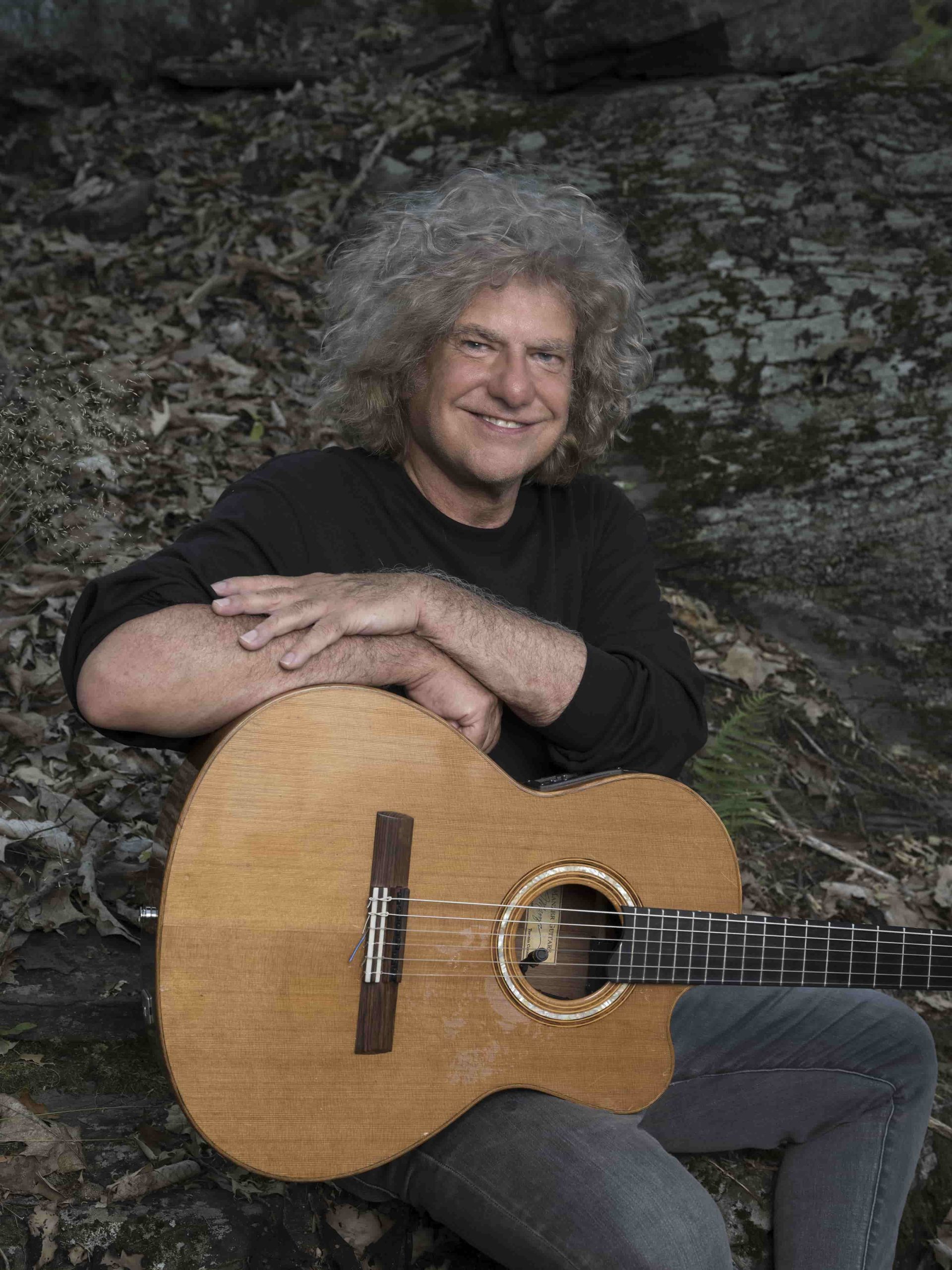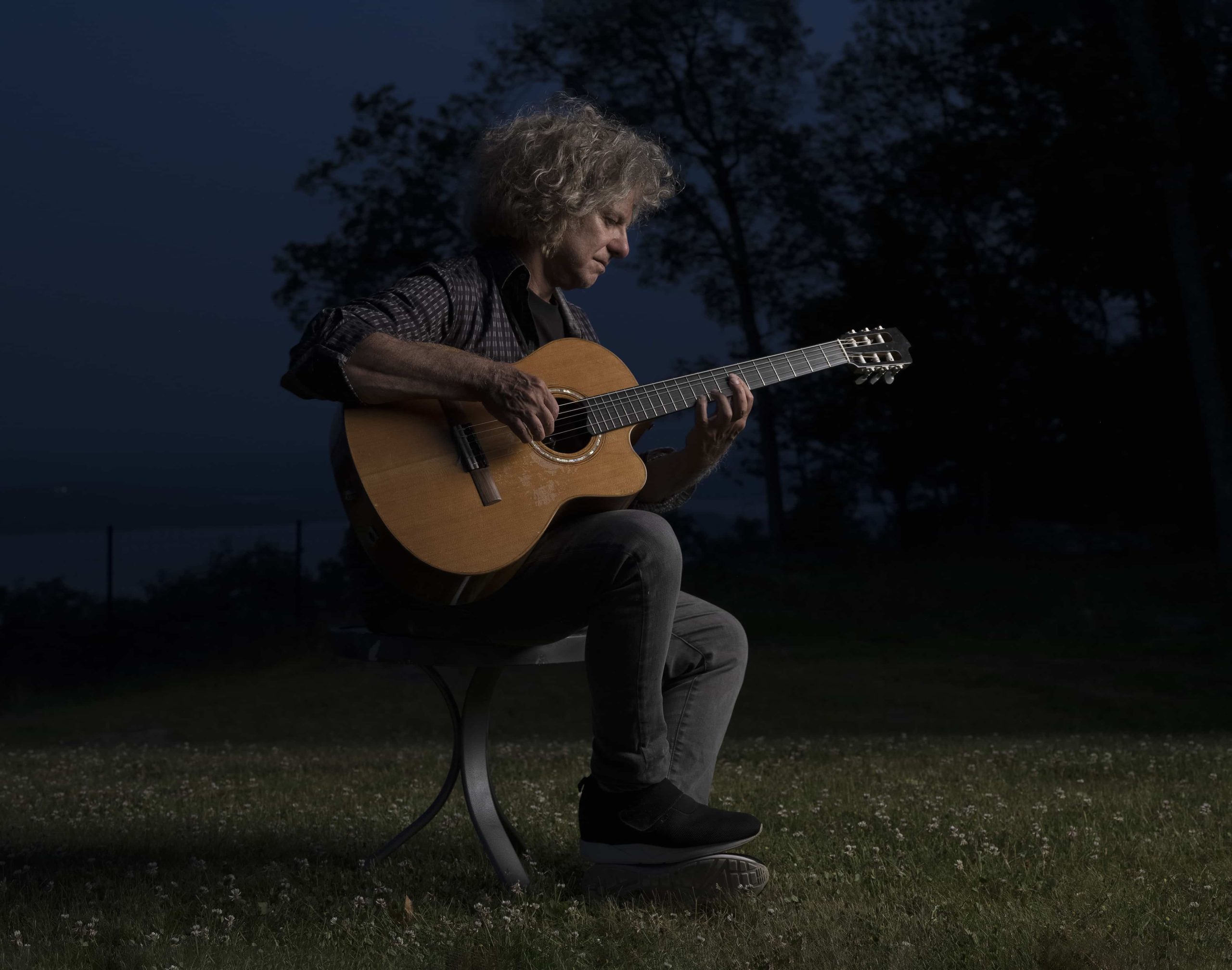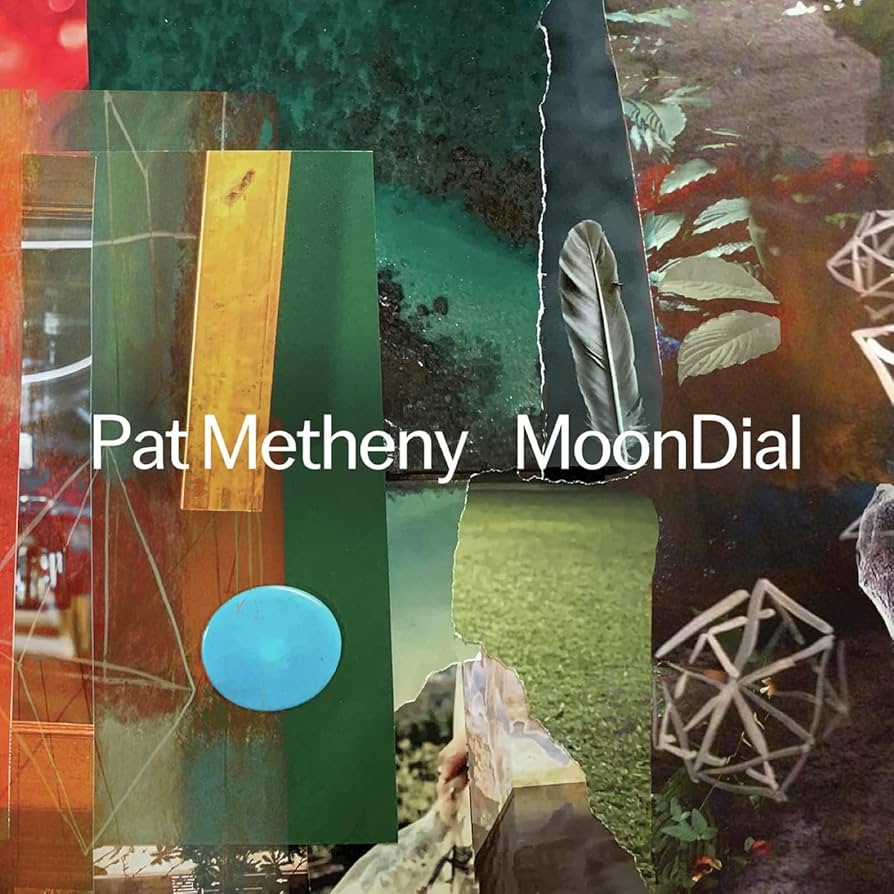Entrevista: Adrián Besada
Fotos cedidas por The Pool G News
Resulta complejo abordar la música de Metheny desde una definición unívoca -convencional- de las nociones de música y jazz. La guitarra ofrecce un rango amplio de posibilidades sonoras, efectos y recursos que el guitarrista estadounidense ha explorado con maestría durante sus más de cincuenta años. Aun así, Metheny es capaz de sorprender año tras año -recordemos que hace tan solo un año publicó Dream Box y hace tres Road To The Sun– con una propuesta diferente.
En ocasiones resulta complicado definir a un artista que, por su música, piensas como un soñador, una especie de compositor impresionista, romántico o dado a cualquier tipo de romantización, pero que resulta una persona de lo más pragmática y serena. Quizás todos estos epítetos convivan, sin embargo, en una de las facetas más interesantes de Metheny, que es la de improvisador. Este reivindica de forma explícita un acercamiento conceptual a la improvisación y a la música, alejado de debates maniqueos sobre la verdad de una y otra cosa, para centrarse en lo que suena, que en esta ocasión es una guitarra barítono con cuerdas de nylon. Su forma de entender la música responde y enfrenta a la actual tendencia de realizar taxonomías constantes, que implica una visión hegeliana de la creación y del arte, por lo que no es casual su acercamiento a autores como Arvo Part, Steve Reich u Ornette Coleman.
En medio de una apretadísima agenda, Metheny atiende a Más Jazz Magazine para hablar en profundidad de su último trabajo y de su particular visión de la música, el género y el estilo, la improvisación y la guitarra:
Va a ser un año intenso para ti, ahora sacas tu nuevo disco en medio de una gira de la que te quedan más de treinta y seis conciertos, ¿cómo llevas esa carga de trabajo?
Pat Metheny: En realidad a estas alturas de las cosas creo que mi último concierto de esta gira fue el show #117…y ha sido una experiencia realmente interesante y divertida para mí hacer una presentación como esta, tan diferente a todo lo que he hecho antes.
Aunque la gira se enmarca bajo el lema de los últimos lanzamientos, estoy aprovechando la oportunidad para echar un vistazo a todos los diferentes tipos de cosas que he hecho en solitario a lo largo de los años. Hay una gran variedad de cosas que suceden a lo largo del camino – es mucho más que un tipo sentado allí tocando una guitarra durante más de dos horas, aunque eso es lo que está sucediendo en el disco MoonDial con ese nuevo instrumento. Pero hay muchas otras cosas que ocurren en el concierto que también reflejan muchos de los otros lanzamientos en solitario anteriores, aunque sólo esté yo en el escenario.
Has publicado discos en solitario anteriormente, pero el sonido de éste es especial, más profundo y menos eléctrico, ¿a qué se debe este cambio? ¿Qué dirías que tiene este disco que no tengan otros, qué lo hace especial?
Pat Metheny: Este periodo comenzó para mí con la publicación del disco Dream Box y la gira que se organizó tras su lanzamiento. Justo antes de irnos, descubrí que tenía una guitarra barítono de cuerdas de nailon que no había podido utilizar porque no tenía el tipo de cuerdas adecuado para ella. Justo cuando nos íbamos, las cuerdas adecuadas aparecieron de la nada, e inmediatamente incorporé ese nuevo sonido de guitarra al repertorio, desde el primer concierto. Pasó de ser sólo un sonido nuevo para mí a convertirse en una parte importante de la presentación. Todo hasta el punto de que en el descanso que acaba de producirse, grabé todo el álbum MoonDial con ese instrumento justo en medio de la gira.
Este nuevo mundo sonoro es algo que resulta especial para mí. Esa grabación es un verdadero disco de continuación de One Quiet Night y What’s It All About en el sentido de que es un disco de guitarra solista pura, pero también un enfoque muy diferente y único de tocar en solitario debido al factor de las cuerdas de nailon que nunca antes había conseguido.

Se trata más bien de instrumentos que contienen tres instrumentos de dos cuerdas que están uno al lado del otro: las dos cuerdas superiores están en el rango de la viola, las dos centrales en el del violín y las dos inferiores en el del violonchelo. Dada la naturaleza de la disposición de una guitarra, eso significa que la «viola» se encarga sobre todo de la melodía y los violines suelen estar más agudos que la melodía, pero desempeñan un papel de acompañamiento.
Ese tipo de pensamiento siempre me ha parecido más parecido a lo que ocurre cuando se escribe para un cuarteto de cuerda o algo así. Eso, a su vez, sugiere un sonido más de guitarra clásica, pero nunca pude encontrar las cuerdas adecuadas para permitir esa afinación en una guitarra barítono clásica de cuerdas de nailon hasta justo antes de que empezara esta gira. Cuando por fin lo conseguí, fue como si se abriera otro universo en ese universo ya de por sí diferente.
Este disco es una profunda reflexión sobre los ámbitos de lo que ese instrumento ofrece de diferente y único.
Has vivido varias épocas del jazz y has sabido adaptarte perfectamente a cada momento, ¿cómo concibes la evolución de tu música? Las tendencias en el sonido de la guitarra de jazz han cambiado mucho, así como el ámbito del género, ¿cómo entiendes el momento actual del jazz en cuanto a estética y sonido?
Pat Metheny: En realidad sólo intento representar honestamente en el sonido las cosas que me gustan de la música. Para empezar, no soy un gran fan de la idea de «género» o estilos musicales. Para mí, la música es algo universal. Los músicos que más he admirado son los que tienen una profunda reserva de conocimiento y perspicacia, no sólo sobre la música, sino sobre la vida en general, y son capaces de iluminar con el sonido las cosas que aman. Cuando se trata de un músico que puede hacer eso sobre la marcha, como improvisador, suele ser mi tipo de músico favorito.
Primero me siento músico en este sentido amplio. Y todos los subconjuntos de la forma en que a menudo se habla de música en términos de las palabras que la gente utiliza para describirla es, básicamente, un debate cultural/político que he descubierto que no me interesa tanto como el espíritu y el sonido de la música en sí.
En cuanto al sonido, siempre intento que sea la música la que decida qué dirección tomo en términos de orquestación. Me gusta tocar de una forma muy densa, o muy dispersa, o muy fuerte o muy suave, o en todo el rango dinámico, dentro o fuera de los acordes… no me importa demasiado, es lo que mejor suena para lo que está sucediendo en ese momento.
Respecto a las escenas que mencionas; en general, siempre me he sentido un poco no alineado. Siempre animo a la gente a crear su propia escena, basada en sus propias realidades. De nuevo, la cuestión del género es más una cuestión cultural, incluso política. Realmente me siento afortunado de poder centrarme en el centro de la cosa y no en las cosas que la rodean.
En discos como éste, la composición prevalece sobre la improvisación, ¿puedes describir un poco tu proceso de creación?
Pat Metheny: No creo que esa caracterización de lo que es este disco sea exactamente correcta sabiendo lo que ocurría mientras lo grababa. De hecho la mayor parte es improvisada. Pero creo que hay una especie de mitología en torno a la palabra improvisación. Cuando se improvisa sobre una composición, digamos un estándar, hay una serie de enfoques que pueden funcionar. Algunos pueden alejarse mucho de la intención original, mientras que otros pueden seguir más de cerca los elementos de la composición original, casi hasta el punto de que suene como una prolongación de la propia composición, por lo que se vuelve borroso. En cierto modo, cuanto mejor se improvisa, más difícil es saber si se trata de una improvisación o no. Al igual que con el sonido y la orquestación, me gusta tener un amplio margen para explorar esas variedades.
¿Habrá nuevos discos de jazz eléctrico? ¿Qué le espera tras el final de esta gira?
Pat Metheny: Como estos dos últimos lanzamientos son lo que son, ha habido gente que se ha preguntado si tocar en solitario es ahora algo exclusivo para mí. No es así. Tengo dos discos nuevos en preparación, y ambos son cosas muy diferentes, con mucha gente y casi exclusivamente con varias guitarras eléctricas, aunque también son bastante distintos entre sí. Me siento como si acabara de empezar.
ENGLISH VERSION
It’s going to be an intense year for you, now you are releasing your new album in the middle of a tour with more than thirty-six concerts to go, how are you coping with that workload?
Pat Metheny: Actually at this point in things I think my last concert of this tour was show #117…and it has been a really interesting and fun experience for me to do a presentation like this one, so different from anything I have done before.
Although the tour is under the banner of the recent release(s), I am using the opportunity to look at all the different kinds of solo things I have done over the years. There is a wide variety of things that happen along the way – it is way more than one guy sitting there playing one guitar for 2+ hours, even though that is what is happening on the MoonDial record with that new instrument. But there are many other things that occur in the concert that reflect many of the other earlier solo releases too even though it is just me onstage.
You have released solo albums before, but the sound of this one is special, deeper, and less electric, what is the reason for this change? What would you say this album has that others don’t have, what makes it special?
Pat Metheny: This period for me began with the release of the Dream Box record and the tour that was set up to follow its release.
Just before we left, I discovered that I had a nylon string baritone guitar that I had not really been able to use because I didn’t have the right kinds of strings for it. Just as we were leaving, the right kind of strings kind of appeared out of nowhere, and I immediately incorporated that new guitar sound as part of the set, starting from gig one. It went from being just a new sound for me to becoming a major part of the presentation. All to the point where on the break that just occurred, I recorded the entire MoonDial album on that instrument right in the middle of the tour.
This new sound world is something that turns out to be special for me. That recording is a true follow up record to One Quiet Night and What’s It All About in that it is a pure solo guitar record, but also a very different and unique approach to playing solo because of the nylon string factor that I had never quite gotten to it before. This record is in line with the two previous acoustic baritone guitar records in that it is just a solo guitar record. So it really is not related to any of my electric stuff at all.
As mentioned, the first baritone record was One Quiet Night and with that tuning (described in many places so I won’t again here) a whole new world opened up for me. I was able to get to voicings and sounds that are just different from a regular guitar, but it therefore requires also a completely different way of thinking.
These are more like instruments that within them contain three two-string instruments that just happen to be sitting right next to each other – the top two strings being in the viola range, the middle two in the violin range and the bottom two in the cello range. Given the nature of how a guitar is laid out, that means the “viola” player mostly has the melody and the violin players are often higher in pitch than the melody but playing an accompaniment role.
That kind of thinking always suggested more like what happens when writing for a string quartet or something. That in turn suggests a more classical guitar type sound – but I was never able to find the right strings to allow that tuning on a nylon-string-classical-baritone guitar until just before this tour began. When I finally cracked it – it was like another universe opened up in that already different universe.
This record is a deep reflection on the areas of what that instrument offers that is different and unique.
You have lived through several jazz eras and you have been able to adapt to each moment perfectly, how do you conceive the evolution of your music? The trends in the sound of jazz guitar have changed a lot, as well as the scope of the genre, how do you understand the current moment of jazz in terms of aesthetics and sound?
Pat Metheny: I reallyjust try to honestly represent in sound the things I love about music. I am not a huge fan of the whole idea of “genre” or styles of music kind of to start with. To me, music is one big universal thing. The musicians who I have admired the most are the ones who have a deep reservoir of knowledge and insight not just about music, but about life in general and are able to illuminate the things that they love in sound. When it is a musician who can do that on the spot, as an improviser, that is usually my favorite kind of player.
I feel like I am a musician in this broad sense first. And all the subsets of the way music often gets talked about in terms of the words people use to describe music is basically just a cultural/political discussion that I have found that I am really not that interested in in the same way I am interested in the spirit and sound of music itself.
As far as sound goes, I always try to let the music at hand decide what direction I go in in terms of orchestration. I am pretty happy to play in a really dense way, or a really sparse way, or really loud or really soft or all over the dynamic range, really inside the chords or outside the chords…it kind of doesn’t matter too much for me – it is whatever seems to sound best for what is happening at that particular moment.
As far as the scenes you mention; in general, I have always felt somewhat non-aligned. I always encourage folks to make their own scene, based on their own realities. Again the issue of genre is more a cultural concern, even a political one. I really feel lucky to be able to just focus on the center of the thing rather than the things around the thing.
In albums like this one, composition prevails over improvisation, can you describe your creation process?
Pat Metheny: I don’t think that characterization of what this record is exactly correct knowing what was happening while I was recording. In fact most of it is improvised. But I think there is a kind of mythology around the word improvisation. When improvising on a composition, say a standard, there are a range of approaches that can work. Some may go far away from the original intent while others may follow the elements of the original composition more closely, almost to the point where it sounds like an extension of the composition itself – so it gets blurry. In a way, the better you get at that kind of improvising, the harder it is to tell whether it is improvised or not. Like with sound and orchestration, I like having a wide berth to explore those varieties.
Will there be new electric jazz albums? What’s in store for you after the end of this tour?
Pat Metheny: Because these last two releases are what they are, there have been some other folks wondering if playing solo is now an exclusive thing for me. It is not. I have two new records in the works, and both are wildly different things with lots of folks and almost exclusively on various electric guitars, while both being quite different from each other too. I feel like I am just getting started.
P. Metheny



